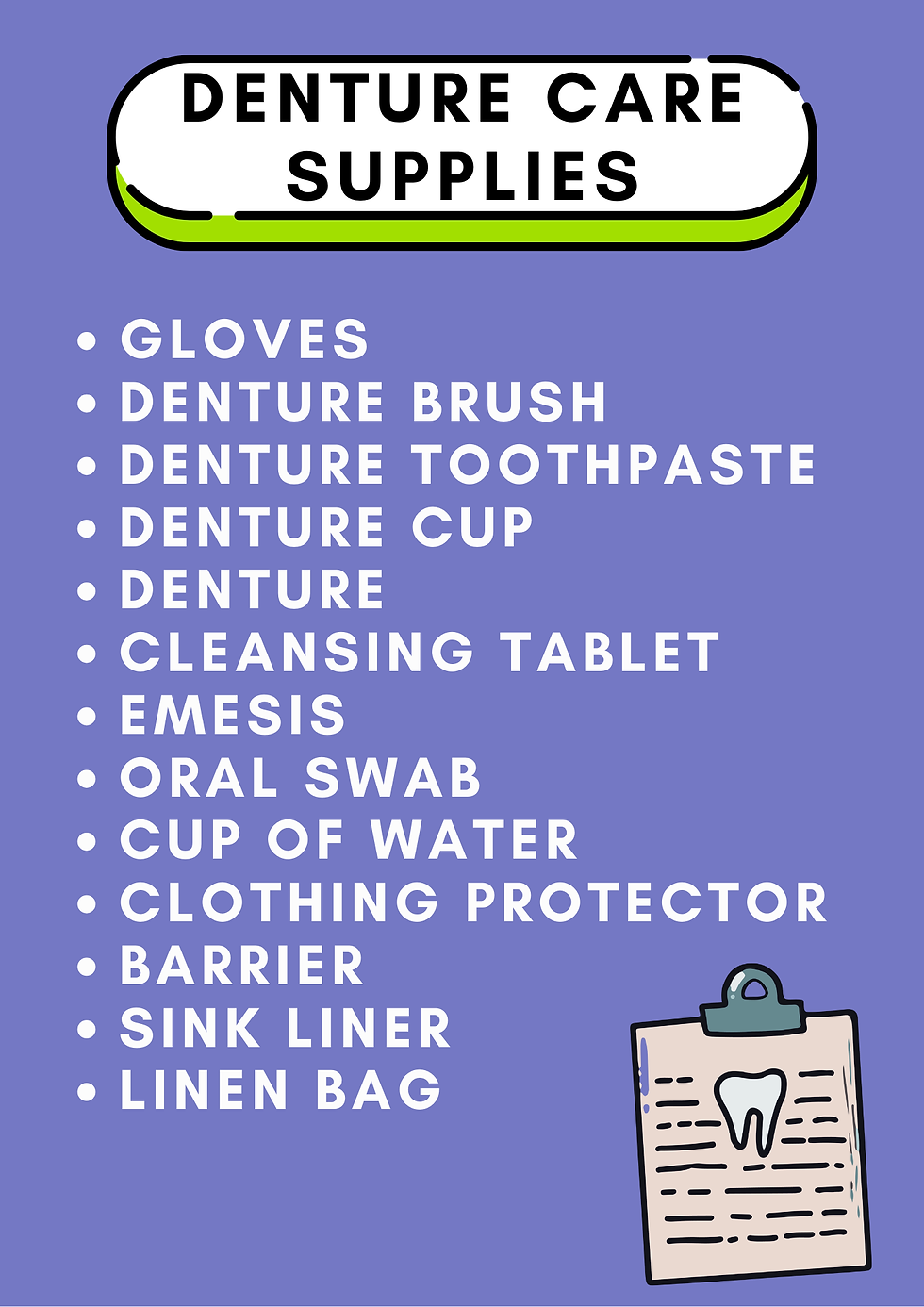Mastering Patient Dental Care for the CNA Exam
- Sarah Cummingham

- Sep 18, 2024
- 3 min read
Updated: Sep 27, 2024
Taking the CNA exam is a crucial step in your journey to becoming a Certified Nursing Assistant. One of the important skills you'll need to demonstrate is providing patient dental care. This guide will walk you through the steps to make learning easy.
Part 1: Dental Care for Bedridden Patients 🦷
Safety and infection control are top priorities when it comes to dental care for patients who can't do it themselves. Remember, saliva is a body fluid, so always wear gloves. Now, let's break it down.

Supplies:
🪥 Barrier for table
🪥 Towel
🪥 Gloves (safety first!)
🪥 Toothbrush
🪥 Toothpaste
🪥 Emesis basin (for spitting)
🪥 Cup of water
Task Breakdown:
Hand Hygiene: Start with clean hands.
Gloves On: Protect yourself and the patient by wearing gloves.
Set Up Supplies: Place everything on a barrier to keep it sanitary.
Elevate the Bed: If the care plan allows, raise the head of the bed to make it easier for the patient.
Protect the Clothing: Cover the patient's chest with a towel to avoid messes.
Wet the Toothbrush: Use the sink or a cup of water.
Apply Toothpaste: Just a tiny dab will do.
Brush Thoroughly: Clean all surfaces of the teeth—inner, outer, and chewing surfaces.
Rinse and Spit: After brushing each section, let the patient rinse with water and spit into the emesis basin.
Tongue Cleaning: Gently clean the tongue, avoiding the gag reflex.
Final Rinse: Help the patient rinse their mouth thoroughly.
Tidy Up: Wipe the patient's mouth with the towel.
Remove the Towel: Place it in a linen bag.
Clean Up Supplies: Empty, rinse, and dry the emesis basin. Rinse the toothbrush and put everything away.
Gloves Off: Remove gloves carefully, turning them inside out.
Hand Hygiene Again: Finish up with clean hands.

Part 2: Denture Care 🦷
Taking care of dentures is just as important as taking care of natural teeth. Here's how to ensure that dentures are sparkling clean.

Supplies:
🪥 Gloves
🪥 Denture brush
🪥 Denture toothpaste (if available)
🪥 Dentures
🪥 Denture cup
🪥 Denture cleansing tablet (optional)
🪥 Emesis/oral basin
🪥 Oral swab
🪥 Cup of water
🪥 Clothing protector (towel)
🪥 Barrier (paper towel)
🪥 Sink liner (paper towel or washcloth)
🪥 Linen bag
Task Breakdown:
Hand Hygiene: Start with clean hands.
Gloves On: Safety first—glove up!
Set Up Supplies: Place everything on a barrier.
Protect the Clothing: Use a clothing protector on the patient.
Line the Sink: Place a washcloth or paper towel in the sink to prevent breakage if dentures are dropped.
Remove Dentures: Carefully remove the dentures and place them in a cup or basin.
Handle with Care: Avoid damaging or contaminating the dentures.
Brush Dentures: Wet the denture brush and apply denture toothpaste.
Clean Thoroughly: Brush all surfaces of the dentures—inner, outer, and chewing surfaces.
Rinse Dentures: Use cool water and place them on a clean barrier or in a basin.
Clean the Cup: Rinse the denture cup.
Store Dentures: Place the dentures in the rinsed cup.
Oral Swab: Wet an oral swab and gently clean the patient's gums and tongue.
Rinse and Spit: Let the patient rinse and spit into the emesis basin.
Reinsert Dentures: Place the dentures back in the patient's mouth if they wish.
Tidy Up: Wipe the patient's mouth and remove the clothing protector, placing it in the appropriate container.
Clean Up Supplies: Rinse the denture brush and emesis basin. Store the equipment properly.
Dispose of Lining: Throw away the sink liner in an appropriate container.
Gloves Off: Remove gloves carefully, turning them inside out.
Hand Hygiene Again: Finish up with clean hands.

🦷 Whether you're providing dental care for bedridden patients or managing dentures, attention to detail, safety, and empathy are key. 🦷






Comments